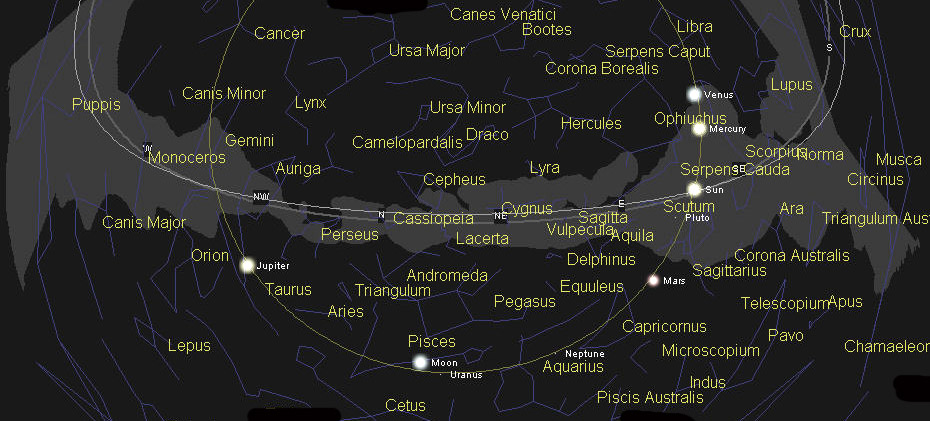It looks like you're using an Ad Blocker.
Please white-list or disable AboveTopSecret.com in your ad-blocking tool.
Thank you.
Some features of ATS will be disabled while you continue to use an ad-blocker.
share:
a reply to: KellyPrettyBear
I appreciate the concern. This time at least, its kind of my own fault. Had to install new lights in my kitchen and instead of waiting for help, I just did it. I didnt want to go through a couple weeks without lights, so, it was worth it. Probably. Its not the first time, and it undoubtedly wont be the last!
I find the different approaches fascinating as well. I can't say its my way either, but that certainly says nothing about validity!
I just enjoy learning how others see things, even when the feeling isn't mutual.
I still see one aspect that doesn't have a comparable story though: transient events. That's small and tiny though, easily dismissed.
I appreciate the concern. This time at least, its kind of my own fault. Had to install new lights in my kitchen and instead of waiting for help, I just did it. I didnt want to go through a couple weeks without lights, so, it was worth it. Probably. Its not the first time, and it undoubtedly wont be the last!
I find the different approaches fascinating as well. I can't say its my way either, but that certainly says nothing about validity!
I just enjoy learning how others see things, even when the feeling isn't mutual.
I still see one aspect that doesn't have a comparable story though: transient events. That's small and tiny though, easily dismissed.
originally posted by: beansidhe
a reply to: Serdgiam
Aah, ok, I'll have a look for a better image. I wanted to ask you some stuff about EM anyway. How would fairies translate in EM terminology?
"Magic"?
Faeries don't like iron right?
Some might not like salt or running water?
Things that muck with EM fields?
MIB seem scared of microwave ovens...
Hmmmmm. Makes you wonder what MIB might be....
Kev
edit on 17-2-2016 by KellyPrettyBear because: (no reason given)
a reply to: KellyPrettyBear
That's right, they hate iron and you can lose them by crossing running water. Do those things mess up EM fields?
That's right, they hate iron and you can lose them by crossing running water. Do those things mess up EM fields?
originally posted by: UniFinity
Also did you check Avatar - English anime, I recommend it.
Another fan of anime here also and have watched a ton of it. : )
I've only watched a few episodes of that one before. I'm more of Dragonball Z fan really when it comes to family-friendly anime. I have a son who is almost 2 years old so I'm hoping he'll enjoy similar stuff as he gets older.
By the way, I've enjoyed your posts on here despite whatever differences in opinion I have. I should also point out that I'm enjoying the mythology-related posts of Kantz and bean, along with everyone else's contributions throughout. I said something similar way back in the thread but I just wanted to point it out again. Even though we've shifted into the dimension of chit-chat I hope you all stick around.
a reply to: KellyPrettyBear
Valid and okay ... I'm still stuck on defining this concept and feel it's lacking something... so bear with me...
bah, I wrote and erased three separate tries at expressing the shade of nuance I feel needs expressing... fourth attempt:
since consciousness as we experience it is a portion of a vast whole (drop of ocean), then what is the distinction between "soul" as tulpa and a little portion of the whole?
And we've also heard possible valid accounts of individuals holding as such through several lifetimes.... what's up w/that?
Imperfect, but my brain isn't at it's best (ever).
Valid and okay ... I'm still stuck on defining this concept and feel it's lacking something... so bear with me...
bah, I wrote and erased three separate tries at expressing the shade of nuance I feel needs expressing... fourth attempt:
since consciousness as we experience it is a portion of a vast whole (drop of ocean), then what is the distinction between "soul" as tulpa and a little portion of the whole?
And we've also heard possible valid accounts of individuals holding as such through several lifetimes.... what's up w/that?
Imperfect, but my brain isn't at it's best (ever).
originally posted by: beansidhe
a reply to: KellyPrettyBear
That's right, they hate iron and you can lose them by crossing running water. Do those things mess up EM fields?
EM means electromagnetic....both electrical and magnetic aspects to a waveform.
Humans have "all elements" and can laugh off a lot of EM (to a point).
Faeries can't. In a manner of speaking, they and Djinn and other critters seem to be some form of "Living EM" just like Tulpas (and shades and souls).
Now presumably there are some slightly more physical components as well...but science starts to fail around that point....dark plasma maybe...
Kev
a reply to: Baddogma
My "soul" apparently knew (and robbed) one of the Buddha's...apparently messed with Dvaita and "black magic" and maybe even hid in the void refusing to die.
(honesty here)
Its not that souls/shades CAN'T survive sometimes....but the SUFFERING that brings can be awful.
I'm glad that soul finally died. It finally grew up.
Now are there "soul like things" call them "holy spirits" that live in the pleroma/"Overworld" that have "bits of us"?
Seems that way.
But obsessing about that is not healthy unless you want to try the path of the gods....and I personally have no interest in that myself..
Kev
My "soul" apparently knew (and robbed) one of the Buddha's...apparently messed with Dvaita and "black magic" and maybe even hid in the void refusing to die.
(honesty here)
Its not that souls/shades CAN'T survive sometimes....but the SUFFERING that brings can be awful.
I'm glad that soul finally died. It finally grew up.
Now are there "soul like things" call them "holy spirits" that live in the pleroma/"Overworld" that have "bits of us"?
Seems that way.
But obsessing about that is not healthy unless you want to try the path of the gods....and I personally have no interest in that myself..
Kev
Anyone else feel the people "chit-chatting" in the illustration on the top of the page are talking a bit close? Chit chat or make out forum? (and how
something can be struck as "off topic" in a chit-chat thread strikes me right back to liminal areas- arches eyebrow lovingly- at mod)
a reply to: Kantzveldt
Does the Sumerian system ever mention, let's call it "necromancey and other "dark arts"?
I'm always fascinated By cultures and systems that have unique understandings and acceptances of "yucky stuff".
Btw...I have nothing against Individuation and long continuation whatsoever...it certainly has an important place.
Kev
Does the Sumerian system ever mention, let's call it "necromancey and other "dark arts"?
I'm always fascinated By cultures and systems that have unique understandings and acceptances of "yucky stuff".
Btw...I have nothing against Individuation and long continuation whatsoever...it certainly has an important place.
Kev
a reply to: Baddogma
lol i was going to make a similar comment and also wondered why this thread was moved to chit chat but i guess it matters little.
On electromagnetism and the fields etc they generate (EMF)
So perhaps particular wavelengths, amounts of energy or frequencies can cause different manifestations/visions or even realign you. If this is true (and it does seem to be) then unfortunately the opposite is presumably true too.
lol i was going to make a similar comment and also wondered why this thread was moved to chit chat but i guess it matters little.
On electromagnetism and the fields etc they generate (EMF)
The Electromagnetic Spectrum
How are energy, frequency, and wavelength related?
Electromagnetic waves can be described by their wavelengths, energy, and frequency. All three of these things describe a different property of light, yet they are related to each other mathematically. This means that it is correct to talk about the energy of an X-ray or the wavelength of a microwave or the frequency of a radio wave.
In fact, X-rays and gamma-rays are usually described in terms of energy, optical and infrared light in terms of wavelength, and radio in terms of frequency. This is a scientific convention that allows the use of the units that are the most convenient for describing whatever energy of light you are looking at. After all - there is a huge difference in energy between radio waves and gamma-rays. Here's an example. Electron-volts, or eV, are a unit of energy often used to describe light in astronomy. A radio wave can have an energy of around 4 x 10-10 eV - a gamma-ray can have an energy of 4 x 109 eV. That's an energy difference of 1019 (or ten million trillion) eV!
So perhaps particular wavelengths, amounts of energy or frequencies can cause different manifestations/visions or even realign you. If this is true (and it does seem to be) then unfortunately the opposite is presumably true too.
I would just like to share this, maybe it will be useful to some who are confused or searching for info.
if anyone is interested about what is the main key which is connecting all religions, spirituality, and maybe even shamanism - visit this site:
www.theself.com...
Simple and to the point. You can get many different books which are quoted on the site or saints in the past, who all have written their wisdom for us, to learn from them. Do not be arrogant and think that what we are searching for is something new or never experienced before by anybody. In every generation there are people who get Self realization, even today in my opinion.
For anyone who want to get past Kundalini and body and mind, than do not focus on them, but learn about the real nature of Self. Well this is just my humble suggestion. Read text from Self-realized masters. There are in every religion.
Look, all else like prana, lucid dreams, astral, critters, Kundalini... is of course connected and you will experiance it all on your quest. They are all a part of the Self and play their roles so we can learn our lessons, but focusing on them will not bring you bliss or end of all suffering or moksha or mukti.
please don't get sidetracked with your own imagination and intelligence.
More intelligence, more thinking, more potential traps. If you are serious about meditation, than try not to think about it at all.
Everything is a natural process and you can let it to move along according to nature of your Self, or your self.
But hey, it is cool to have fun and explore whatever you desire. but the moment you start to suffer from it in any way...stop immediately, you are doing something wrong and should turn back to the Self.
Pure silence.
Pure feelings.
imho
if anyone is interested about what is the main key which is connecting all religions, spirituality, and maybe even shamanism - visit this site:
www.theself.com...
Simple and to the point. You can get many different books which are quoted on the site or saints in the past, who all have written their wisdom for us, to learn from them. Do not be arrogant and think that what we are searching for is something new or never experienced before by anybody. In every generation there are people who get Self realization, even today in my opinion.
For anyone who want to get past Kundalini and body and mind, than do not focus on them, but learn about the real nature of Self. Well this is just my humble suggestion. Read text from Self-realized masters. There are in every religion.
Look, all else like prana, lucid dreams, astral, critters, Kundalini... is of course connected and you will experiance it all on your quest. They are all a part of the Self and play their roles so we can learn our lessons, but focusing on them will not bring you bliss or end of all suffering or moksha or mukti.
please don't get sidetracked with your own imagination and intelligence.
More intelligence, more thinking, more potential traps. If you are serious about meditation, than try not to think about it at all.
Everything is a natural process and you can let it to move along according to nature of your Self, or your self.
But hey, it is cool to have fun and explore whatever you desire. but the moment you start to suffer from it in any way...stop immediately, you are doing something wrong and should turn back to the Self.
Pure silence.
Pure feelings.
imho
edit on 1455737243227February272272916 by UniFinity because: (no reason given)
edit on 1455737303228February282282916 by
UniFinity because: (no reason given)
a reply to: KellyPrettyBear
Okay... defining terms is the key (to most everything).
Tulpa: conscious energy construct created through concentration by an existing conscious energy construct...
Soul: conscious energy construct (created by individuation from the greater conscious whole)
so the distinction and question, as I partially understand it, is:
if a Tulpa is created by an existing "soul" ... and a "soul" is created by who knows what process, but is drawn from the same conscious pool of wholeness, then what is the distinction? Water drawn from the ocean and then poured into a glass is still ocean, no?
Remember I lack refinement in the terms and concepts used, and might just need to read a book, but am I making sense?
eta: aren't we ALL tulpas?
Okay... defining terms is the key (to most everything).
Tulpa: conscious energy construct created through concentration by an existing conscious energy construct...
Soul: conscious energy construct (created by individuation from the greater conscious whole)
so the distinction and question, as I partially understand it, is:
if a Tulpa is created by an existing "soul" ... and a "soul" is created by who knows what process, but is drawn from the same conscious pool of wholeness, then what is the distinction? Water drawn from the ocean and then poured into a glass is still ocean, no?
Remember I lack refinement in the terms and concepts used, and might just need to read a book, but am I making sense?
eta: aren't we ALL tulpas?
edit on 2/17/2016 by Baddogma because: (no reason given)
a reply to: Baddogma
Hey look on the bright side...this means that kundalini, faerie lore, lost Sumerian secrets and the ultimate secrets of time, space and the soul are now logically equivalent to, and as socially acceptable as Paris Hilton breast implants!
Congratulations! We have ARRIVED!
But it's like dressing Sauron in a tu tu dress... it takes the mysterious and arcane feeling out of it.
But if I were to post about sasquatch I could do that all day in a "mysterious forum".
Kev
Hey look on the bright side...this means that kundalini, faerie lore, lost Sumerian secrets and the ultimate secrets of time, space and the soul are now logically equivalent to, and as socially acceptable as Paris Hilton breast implants!
Congratulations! We have ARRIVED!
But it's like dressing Sauron in a tu tu dress... it takes the mysterious and arcane feeling out of it.
But if I were to post about sasquatch I could do that all day in a "mysterious forum".
Kev
a reply to: UniFinity
Knowing that your post was a general one not directed at me, necessarily, but it illustrates that "yes, baddogma just needs to read more stuff and refresh his faded knowledge base," heh...
Zen Buddhism (if that is from where that link gets it's basis) is one strongly logical system that I find has truth and thanks for the resource... I will explore it and forget my bias against "religion" as Buddhist thought resists "isms" and religions ...and is thus difficult for many Westerners to approach.
Knowing that your post was a general one not directed at me, necessarily, but it illustrates that "yes, baddogma just needs to read more stuff and refresh his faded knowledge base," heh...
Zen Buddhism (if that is from where that link gets it's basis) is one strongly logical system that I find has truth and thanks for the resource... I will explore it and forget my bias against "religion" as Buddhist thought resists "isms" and religions ...and is thus difficult for many Westerners to approach.
a reply to: KellyPrettyBear
a reply to: johnb
Ah, got you, thanks.
en.wikipedia.org...
I'm not going to pretend to know the science, but then this is starting to remind me of Lyall Watson's book again. KPB, this is why you were saying they're jealous of our bodies..I'm starting to get you, I think.
a reply to: johnb
Ah, got you, thanks.
Many behavioral effects at different intensities have been reported from exposure to magnetic fields, particularly with pulsed magnetic fields. The specific pulseform used appears to be an important factor for the behavioural effect seen; for example, a pulsed magnetic field originally designed for spectroscopic MRI, referred to as Low Field Magnetic Stimulation, was found to alleviate symptoms in bipolar patients,[5] while another MRI pulse had no effect. A whole-body exposure to a pulsed magnetic field was found to alter standing balance and pain perception in other studies.[6][7]
en.wikipedia.org...
I'm not going to pretend to know the science, but then this is starting to remind me of Lyall Watson's book again. KPB, this is why you were saying they're jealous of our bodies..I'm starting to get you, I think.
edit on 17-2-2016 by beansidhe because: link
a reply to: KellyPrettyBear
Okay! At least we have paved the rough pothole filled road I was having trouble navigating... what you are basically saying is that we are all dreamstuff and any arrangement of dreamstuff amounts to the same dream.
Just one dream checking with another wad of dreamstuff!
Okay! At least we have paved the rough pothole filled road I was having trouble navigating... what you are basically saying is that we are all dreamstuff and any arrangement of dreamstuff amounts to the same dream.
Just one dream checking with another wad of dreamstuff!
a reply to: beansidhe
Yes i'm very sure that's right now for the Mesopotamians because as Delphinus regulates the sap he has to be around at the base of their sacred tree or slightly beneath it, because the feed system is up through the roots, but you were correct when you considered that the relationship to the Milky Way and exliptic plane would have to be important and it is, the source for the water that feeds the roots is drawn off at Scorpio-Sagittarius, it could also perhaps be seen to evaporate off at the upper levels feeding back into the river at Taurus-Gemini, so it seems to be the case they thought of everything.

The ecliptic plane-Galactic equator intersection point at Taurus-Gemini was considered the entrance into the Underworld, that at Scorpio the way out, so there was an associated birth Goddess.

What this means is that if you wanted to remove any blockage in the system the best way would be to increase the flow and force any blockage through increased pressure, or at least that would be the crazy way to go about things which is generally preferred, so you need to open the sluice gates at Scorpio wide open and that feeds into the system.

Seals showing this relationship of a birthing Goddess to Scorpio are very old and obscure, the position she takes is close to that of Canis Major and again there is some relationship between the primary and terminal points of the axis.

The same basic principles can be applied to your average kundalini shaman, that the basis of the energies involved can be understood as rising up though the Earth, but if the flood gate is opened feeding into the system that will pretty much blow his head off, metaphorically speaking.

The river management tradition is then the an important feature of Mesopotamian mystical understandings.
a reply to: KellyPrettyBear
Yes they had a festival involving the return of the Dead on a temporary vacation, see The Gate of Dreams
Yes i'm very sure that's right now for the Mesopotamians because as Delphinus regulates the sap he has to be around at the base of their sacred tree or slightly beneath it, because the feed system is up through the roots, but you were correct when you considered that the relationship to the Milky Way and exliptic plane would have to be important and it is, the source for the water that feeds the roots is drawn off at Scorpio-Sagittarius, it could also perhaps be seen to evaporate off at the upper levels feeding back into the river at Taurus-Gemini, so it seems to be the case they thought of everything.

The ecliptic plane-Galactic equator intersection point at Taurus-Gemini was considered the entrance into the Underworld, that at Scorpio the way out, so there was an associated birth Goddess.

What this means is that if you wanted to remove any blockage in the system the best way would be to increase the flow and force any blockage through increased pressure, or at least that would be the crazy way to go about things which is generally preferred, so you need to open the sluice gates at Scorpio wide open and that feeds into the system.

Seals showing this relationship of a birthing Goddess to Scorpio are very old and obscure, the position she takes is close to that of Canis Major and again there is some relationship between the primary and terminal points of the axis.

The same basic principles can be applied to your average kundalini shaman, that the basis of the energies involved can be understood as rising up though the Earth, but if the flood gate is opened feeding into the system that will pretty much blow his head off, metaphorically speaking.

The river management tradition is then the an important feature of Mesopotamian mystical understandings.
a reply to: KellyPrettyBear
Yes they had a festival involving the return of the Dead on a temporary vacation, see The Gate of Dreams
edit on Kpm22947vAmerica/ChicagoWednesday1729 by Kantzveldt because: (no reason given)
new topics
-
Sorry to disappoint you but...
US Political Madness: 40 minutes ago -
Watch as a 12 million years old Crab Emerges from a Rock
Ancient & Lost Civilizations: 5 hours ago -
ILLUMINATION: Dimensions / Degrees – Da Vincis Last Supper And The Philosophers Stone
Secret Societies: 11 hours ago
top topics
-
Speaking of Pandemics
General Conspiracies: 14 hours ago, 9 flags -
ILLUMINATION: Dimensions / Degrees – Da Vincis Last Supper And The Philosophers Stone
Secret Societies: 11 hours ago, 9 flags -
Watch as a 12 million years old Crab Emerges from a Rock
Ancient & Lost Civilizations: 5 hours ago, 9 flags -
Just Sick of It! Done! Can't take it anymore!
General Chit Chat: 12 hours ago, 8 flags -
Stuck Farmer And His Queue Jumping Spawn
Rant: 14 hours ago, 4 flags -
Sorry to disappoint you but...
US Political Madness: 40 minutes ago, 4 flags
active topics
-
Sorry to disappoint you but...
US Political Madness • 2 • : 38181 -
Joe Biden gives the USA's Highest Civilian Honor Award to Hillary Clinton and George Soros.
US Political Madness • 41 • : Flyingclaydisk -
Just Sick of It! Done! Can't take it anymore!
General Chit Chat • 14 • : Flyingclaydisk -
What Is 'Quad Demic'? Mask Mandate Returns In These US States
Diseases and Pandemics • 38 • : NorthOS -
Musk calls on King Charles III to dissolve Parliament over Oldham sex grooming gangs
Mainstream News • 176 • : cherokeetroy -
Winter Storm
Fragile Earth • 32 • : Irishhaf -
Vehicle Strikes people in New Orleans
Mainstream News • 300 • : Oldcarpy2 -
DONALD J. TRUMP - TIME's Most Extraordinary Person of the Year 2024.
Mainstream News • 61 • : Oldcarpy2 -
Candidate Harris Supporter MARK CUBAN Says Trump Has No Smart-Intelligent Women in His Orbit.
2024 Elections • 88 • : Oldcarpy2 -
Matthew Livelsberger said he was being followed by FBI
Political Conspiracies • 72 • : WeMustCare
